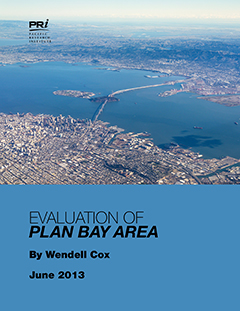The Pacific Research Institute released a new study on the proposed Plan Bay Area. The study describes the proposals regulatory overreach and its detrimental consequences for Bay Area residents and the metropolitan economy. In addition, the study shows that improved fuel efficiency by 2035 will more than meet the requirements for greenhouse gas emissions reductions for the Bay Area, eliminating the need for the extreme measures proposed in the plan. Evaluation of Plan Bay Area was authored by Wendell Cox, a PRI fellow and consultant on public policy, planning, and transportation issues.
Plan Bay Area sets out a vision for transportation and land use over the next quarter century. Developed by the Association of Bay Area Governments (ABAG) and the Metropolitan Transportation Commission (MTC), each of the states regional planning areas including the Bay Area is required by law to produce a long-term plan to reduce greenhouse gas emissions. The Bay Area has been tasked by the California Air Resources Board with a 15 percent per capita reduction by 2035.
Plan Bay Area takes behavior modification to a new intensity, Mr. Cox said. The plan seeks to reduce greenhouse gas emissions by reducing automobile use and by forcing people to live in smaller houses and at much higher densities. Between now and 2040, more than three quarters of the new houses would be built on high density transit oriented developments or priority development areas. According to Mr. Cox, Plan Bay Area advances the delusion that Americans are tired of the detached house, suggesting that fewer will be needed by 2040, even with a larger population.
Development constraints will lead to unaffordable housing
Mr. Cox notes that the proposed Plan Bay Area would allow little or no new development beyond the urban fringe, where cities have grown naturally since the beginning of time .Similar, though less draconian constraints on urban fringe development have been employed for 40 years in the Bay Area. The result has been to more than double house prices relative to incomes, making home ownership affordable only to the affluent. He added, Even after playing musical chairs with the lives of seven million current residents and a million additional residents who could move here by 2040, Plan Bay Area says that people will drive cars just about as much as they do now. But its critical to note that much of this traffic would be concentrated around the priority development areas, which would intensify traffic congestion and air pollution and its relative health impacts.
None of this is necessary
The U.S. Department of Energy forecasts that automobile fuel efficiency will improve materially by 2040. The improved fuel economy would reduce per capita greenhouse gas emissions 49 percent by 2040, more than 2.5 times the 15 percent required by 2035, after adjustment to include the 2035-2040 period. This puts an end to the shibboleth more diving will negate any fuel economy improvements since overall emissions in the bay Area would fall 40 percent, said Mr. Cox. He added that the impact of these technology improvements is so great that little of the improvement in greenhouse gas emissions over the next quarter-century would be attributable to Plan Bay Areas behavior modification strategies.
Mr. Cox concludes, Improving technologies provide California and its planning agencies an important opportunity to turn their backs on the policy overreach that has already produced an extraordinarily high cost of living and some of the nation’s worst traffic congestion. San Francisco Bay officials should instead focus on facilitating the aspirations of present and future residents.
To learn more about Evaluation Plan Bay Area or to arrange an interview with author Wendell Cox, please contact Rowena Itchon at PRIs Press Office at (415) 955-6123 or Laura Dannerbeck at [email protected].

